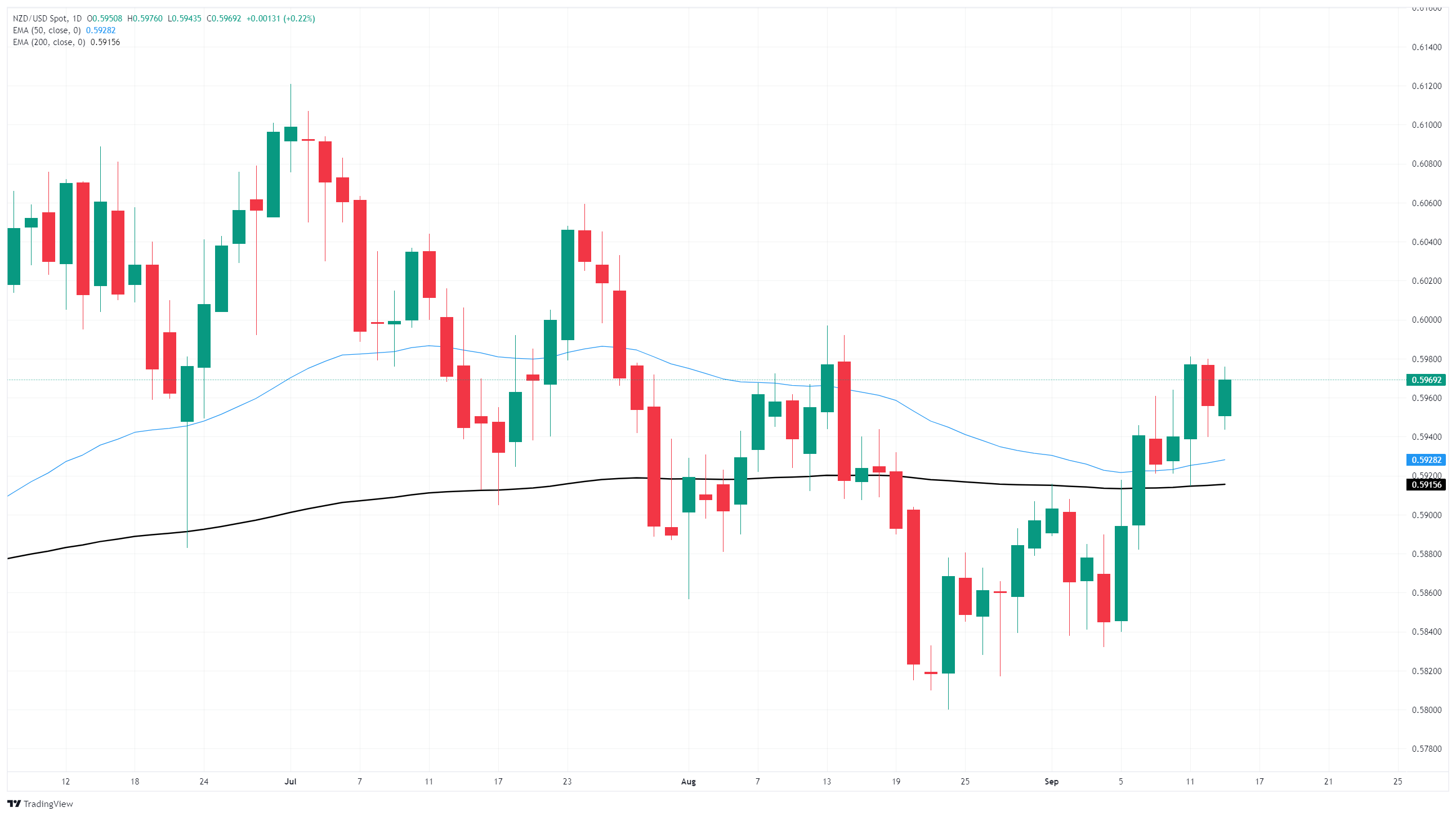NZD/USD poised for further gains as US Dollar flows falter
- NZD/USD held steady near recent highs on Monday.
- Upcoming New Zealand GDP figures are expected to show economic contraction.
- The Fed’s looming interest rate call is widely expected to kick off a rate-cutting cycle.
NZD/USD looked upwards on Monday, testing chart territory just south of 0.5980. The New Zealand Dollar (NZD) has caught a near-term gust of bidding wind as the US Dollar (USD) slumps ahead of the latest interest rate call from the Federal Reserve (Fed). The Fed is broadly expected to kick off a new rate-cutting cycle, and investors will be keeping their heads down in the run-up to Wednesday’s rate call.
The Fed will also be delivering its latest Summary of Economic Projections (SEP), the ‘dot plot’ of what interest rate changes Fed policymakers believe will happen in the near future. Markets are broadly expecting the Fed to deliver three straight 25 basis-point interest rate cuts through the end of the year, and traders will be looking to see signs that the Fed’s SEP lines up with current rate expectations. The Fed will deliver its latest interest rate decision on Wednesday.
New Zealand’s latest GDP figures, due on Thursday, are expected to show a quarterly contraction in NZ growth metrics. New Zealand’s second-quarter growth is expected to backslide by 0.3% QoQ, and contract by a slight 0.1% on the annualized figure.
NZD/USD price forecast
The Kiwi is testing into recent highs near 0.5980, but the 0.6000 handle remains well out of reach of current technical momentum. The pair is running out of bullish gas after breaking through the 200-day Exponential Moving Average (EMA) near 0.5915, and a technical resistance zone is baking into the charts near current price action, warning of another leg lower.
NZD/USD daily chart

New Zealand Dollar FAQs
The New Zealand Dollar (NZD), also known as the Kiwi, is a well-known traded currency among investors. Its value is broadly determined by the health of the New Zealand economy and the country’s central bank policy. Still, there are some unique particularities that also can make NZD move. The performance of the Chinese economy tends to move the Kiwi because China is New Zealand’s biggest trading partner. Bad news for the Chinese economy likely means less New Zealand exports to the country, hitting the economy and thus its currency. Another factor moving NZD is dairy prices as the dairy industry is New Zealand’s main export. High dairy prices boost export income, contributing positively to the economy and thus to the NZD.
The Reserve Bank of New Zealand (RBNZ) aims to achieve and maintain an inflation rate between 1% and 3% over the medium term, with a focus to keep it near the 2% mid-point. To this end, the bank sets an appropriate level of interest rates. When inflation is too high, the RBNZ will increase interest rates to cool the economy, but the move will also make bond yields higher, increasing investors’ appeal to invest in the country and thus boosting NZD. On the contrary, lower interest rates tend to weaken NZD. The so-called rate differential, or how rates in New Zealand are or are expected to be compared to the ones set by the US Federal Reserve, can also play a key role in moving the NZD/USD pair.
Macroeconomic data releases in New Zealand are key to assess the state of the economy and can impact the New Zealand Dollar’s (NZD) valuation. A strong economy, based on high economic growth, low unemployment and high confidence is good for NZD. High economic growth attracts foreign investment and may encourage the Reserve Bank of New Zealand to increase interest rates, if this economic strength comes together with elevated inflation. Conversely, if economic data is weak, NZD is likely to depreciate.
The New Zealand Dollar (NZD) tends to strengthen during risk-on periods, or when investors perceive that broader market risks are low and are optimistic about growth. This tends to lead to a more favorable outlook for commodities and so-called ‘commodity currencies’ such as the Kiwi. Conversely, NZD tends to weaken at times of market turbulence or economic uncertainty as investors tend to sell higher-risk assets and flee to the more-stable safe havens.

